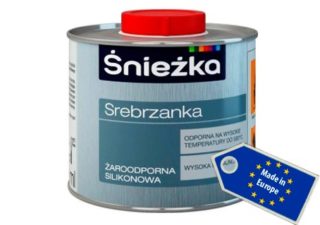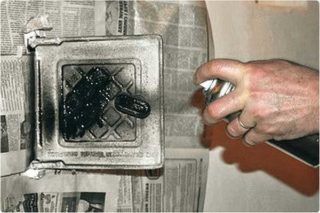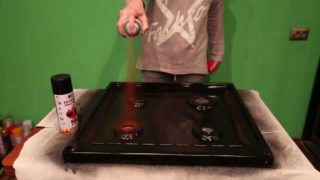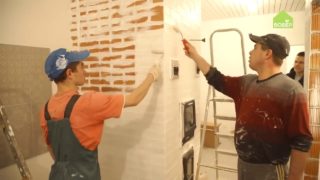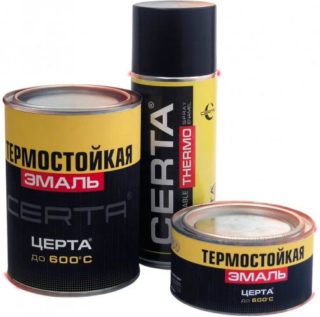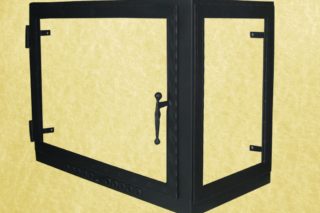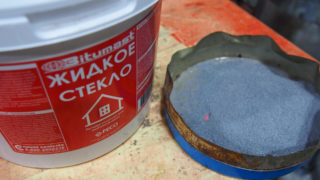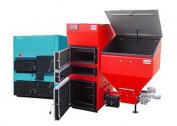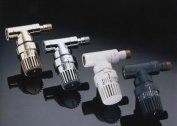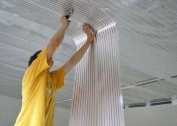Most coatings are operated in the temperature range up to +80 С. Such options are not suitable for painting stoves, barbecues, fireplaces. Paint for furnaces heat-resistant withstands heating up to +1000 C and extends the life of products.
Varieties of materials
Resistance to a particular temperature is determined by the ingredients. Compositions withstanding heat above +100 C are made on the basis of zinc compounds and alkyd resins. Heat-resistant special paint for furnaces includes heat-resistant glass.
It is necessary to distinguish between heat-resistant and fire-resistant paint. The first option withstands high surface heating temperatures. To some extent, it is resistant to fire - such compounds are used to paint the grill grill or fireplace grate. Fire resistant paint protects the surface from fire. They give a pleasant appearance and prevent overheating of iron structures in contact with fire.
For domestic use
The temperature of heating surfaces is different. Pipes of hot water supply and water heating never heat above +100 C. They are painted with the simplest compounds. The working surfaces of the fireplace and stove heat up much more: it requires heat-resistant paint for a barbecue or brick oven.
Details of the barbecue and fireplace, heating above +800 C, are coated with heat-resistant enamels - compositions that withstand heating up to +1000 C.
This is not the only parameter by which the coloring composition is chosen. More informative is the classification by composition:
- Acrylic - suitable for painting the pipeline, heating system, heating tank, gas boiler. They tolerate heating up to +100 C. Acrylic paints protect iron from rust, have no smell and dry quickly. The main advantage is safety.
- Alkyd - resistant to temperatures up to +150 C. The scope is the same as that of acrylic. Plus - alkyd compounds paint both wood and metal surfaces.
- Epoxy - retain their properties up to +400 C. Metal crumb or powders are introduced into the composition. Brick and metal stoves are treated with epoxy mixtures in a bathhouse.
- Silicone - the coating receives resistance to temperature by adding organosilicon components. One of the main qualities of silicon and its compounds is its refractoriness; the substance melts at temperatures from +1400 to +2000 С. A paint with such additives transfers heat to +1000 C.
Thermo-paint is produced in banks and buckets, as well as in the form of aerosols. The last option is very convenient for home use: the paint lies in a thin even layer, from the spray can be painted the most inaccessible places.
Unary
One-component compositions, epoxyether or ethyl silicate, are distinguished in a separate category. Resistance to heating - up to +400 C, the paint provides the addition of metal powder. The compositions are used for coloring parts of the barbecue or barbecue in contact with fire.
Such paints are chemical resistant and protect the metal from corrosion.
For professional use
The fundamental difference between household and professional compositions is not so much the composition or quality of the enamel as the application method. Such mixtures create a denser layer, are not subject to mechanical damage, more resistant to temperature due to uniform coating.
First of all, it is silicone high-temperature paint. She is painted with metal, brick, stone. Professionals apply it in an aerosol way, since this method guarantees uniformity of staining.
The properties of the heat-resistant coating appear only after hardening. The dried surface must be heated at 250-300 C for 0.5-3 hours. To do this, use a soldering iron, torch, test firebox.
Another option is metal refractory powder paint for furnaces. Most often applied by electrostatic spraying. For staining, special equipment is used.
For industrial use produce special compositions with the addition of quartz, high silica glass. They are stable up to a temperature of +1200 С. They are used for very hot parts of equipment in mechanical engineering, chemical and thermal industries.
Advantages of heat-resistant paint
Enamels vary greatly in composition, therefore their properties and purpose are different. Common benefits include:
- Resistance to temperature - from +100 to +1000 C.
- Heat resistant metal paint for furnaces protects against rust, as it forms a very dense hydrophobic layer.
- All coatings are resistant to chemical aggressors. Paints for the chemical industry can withstand concentrated solutions of acids and alkalis.
- Thermal coating is plastic. When heated above +500 C, metals and clay expand. Conventional paint is cracked and the protective properties of the layer are reduced. Thermal paints expand with the material.
- The coating is scratch and impact resistant. This is important, since the pipes, fireplace grate, barbecue grill are subjected to mechanical stress.
- The color scheme of thermal paints is very wide. Matte, smooth, glossy coating of different shades gives the product an appeal.
- Service life depends on operating conditions. The average is 10-12 years.
There are also disadvantages:
- high price;
- high consumption - often you need to apply a coating in several layers;
- difficulty in coloring - most heat-resistant and heat-resistant enamels need to be hardened.
The hardening procedure when painting a stove or fireplace is a test firebox. The fireplace is not kindled at full power, can withstand half an hour, and then increase the heat for 1.5–2.
Criteria for choosing a composition
Paint for a stove made of metal or brick is selected, taking into account a number of parameters:
- Heat resistance - the indicator is indicated in the marking of the paint. The composition is selected in accordance with the level of heating of the boiler or bath furnace. For factory boilers, this figure is indicated in the passport. The heating temperature of a brick oven or fireplace is determined using a thermal pencil or thermal imager.
- Scope - a coating that can withstand high temperatures, is not always resistant to fire. These compounds are not interchangeable, so for the fireplace grate you will have to look for refractory paint, not heat-resistant.
- Consumption is the covering ability of the mixture. The higher it is, the fewer layers will have to be applied.
- Production time - the activity of the substances in the composition decreases over time. Paint whose expiration date is no longer so resistant to temperature.
Aerosols are preferred. They are more effective than the regular liquid version. It is not recommended to use mixtures intended for spray guns for painting furnaces or barbecues: they are more liquid, which reduces heat resistance.
For brick kilns
Bricks heat less than metal, as they partially accumulate heat. However, in the furnace there are also metal elements: doors, dampers. For staining, different compositions are required:
- Heat-resistant paint for cases of fireplaces and stoves - epoxy or ethyl silicate compounds. They withstand heat up to +400 C, which is quite enough. A good option is the paint "Alpha", "Emelya", Ecoretta.
- Metal parts are painted with a more stable composition - Elcon KO-8101, "Certa". It tolerates heating up to +998 C. The paint is hydrophobic and protects cast iron and steel from corrosion.
The exhaust pipes, the lower part of the chimney are painted with a more heat-resistant composition.
For metal structures
The metal heats up a lot more. The indicators are slightly different. Cast iron is able to accumulate heat, so it heats less. Compared to steel, brass conducts heat worse and also heats less. However, the temperature range starts at + 500–600. C, therefore, only special paints can be used for coloring.
A mandatory requirement is insensitivity to moisture. Spray formulations are preferred. The most famous on the market are Certa, Termal, Kudo - on an organosilicon basis.
Enamel Characteristics
The table shows the requirements for universal paints suitable for painting both stone and metal.
| Dry residue,% | 40 | 45/38 | 50 |
| Drying time, hour | 2 | 2 | 2 |
| Hardness of coating, cu | 0,4 | 0,4 | 0,4 |
| Resistance to water, hour | 24 | 24 | 48 |
| Impact strength, cm | 40 | 40 | 40 |
| Heat resistance at +600 C, hour | 5 | 3 | 3 |
| Consumption per g / sq. m | 130–150 | 130–150 | 130–150 |
| Salt spray resistance | 96 | 100 | 96 |
Tests are carried out at a normal temperature of +20 C and during heating. Data are for normal temperature.
Surface preparation and painting
For thermal paint for fireplaces and stoves to last a long time, you need to prepare the surface for painting. Procedure:
- The surface is cleaned of dust and dirt. The metal case is freed from rust, coating and traces of old painting. Use sandpaper, an iron brush, a nozzle on a drill.
- The surface is washed with water and degreased with a solvent.
- After complete drying, they begin staining. Liquid paint is applied in several thin layers with a roller or brush. The next layer is laid after the previous one has dried.
- Shake the aerosol can for at least 2 minutes, then spray the mixture with a thin layer. Apply crosswise from a distance of 20-30 cm. Usually requires at least 3 layers. Each layer dries in 30 minutes.
Drying time and application features of a particular paint are described in the instructions. Before work, you must familiarize yourself with it.
Homemade Refractory Paint
Paint for brick or metal stoves can be made independently. This requires 2 ingredients: aluminum powder and liquid glass.
- Powder is placed in a wide-necked plastic bottle, and then potassium silicate is carefully poured. Shake the bottle until both components are mixed.
- The composition can be used immediately after manufacture. The color is silver-white.
- Apply the mixture with a brush or roller in at least 2 layers. The spray gun cannot be used.
For the manufacture of using only potassium silicate. Sodium silicate can not be used.
Thermal enamels for various purposes are used to paint any heated surfaces. When choosing, you need to take into account not only resistance to temperature, but also the composition of the paint, purpose, method of application.
